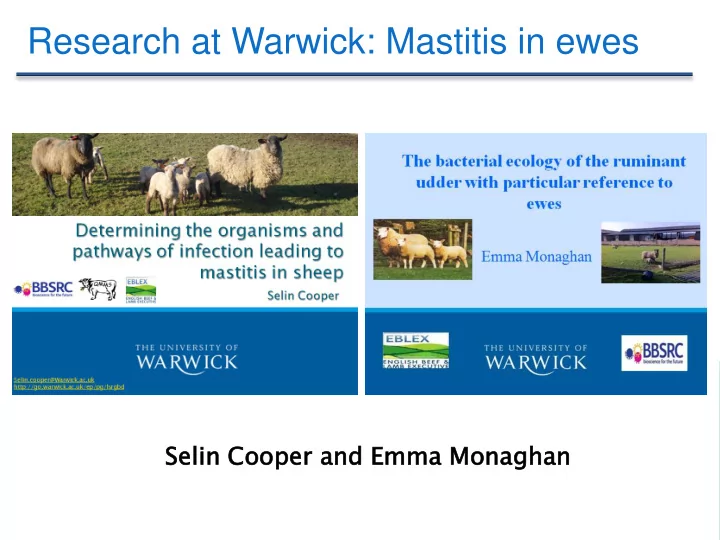

Research at Warwick: Mastitis in ewes Selin n Coope per r and Emma ma Monagha aghan
Determining the organisms and pathways of infection leading to mastitis in sheep Selin Cooper E-mail: Selin.cooper@Warwick.ac.uk Research Page http://go.warwick.ac.uk/ep/pg/lsrgbd
Mastitis: an overview Definition • Mastitis occurs when a bacterial infection in the udder causes inflammation • It can be caused by a variety of bacteria Identification • Identified by the somatic cell count (SCC) in the milk, bacteriology and/or clinical signs
Loss of Loss of ↓ LWG ↓ Yield half half Mastitis research at Warwick
PCR • Understand the natural microbial community in the udder • How this changes with time and age of ewe DGGE DNA sequencing MLST PFGE Multilevel multivariable modelling Mass spectrometry • Understand the development of mastitis in the udder from bacterial colonisation to the diseased state Traditional culturing techniques Mastitis research at Warwick
• Investigate the development of mastitis, from colonisation with an infecting strain to development of disease • Determine links between environmental strains of bacteria and the intramammary infections they cause • Identify management and environmental factors that are associated with a ewe’s risk of developing mastitis Mastitis research at Warwick
Ewes with no clinical mastitis Ewes with clinical mastitis Same/different species/strains Same strains Mastitis research at Warwick
Flock • 100 pedigree Texel ewes Number of samples • 28 milk samples from ewes with clinical mastitis • 5 milk samples from ewes without clinical mastitis • 14 swabs Sample storage • Milk stored at -80 ° C with glycerol • Swabs stored at -80 ° C in BHI and glycerol Mastitis research at Warwick
Methods to use • Culture and sterile streak all isolates identified • Use MALDI-TOF-MS to identify species from the majority of samples • Use species information to decide on which isolates to strain type • Use PFGE to strain type • Use statistical analyses to investigate links between isolates Mastitis research at Warwick
Mastitis research at Warwick
Mastitis research at Warwick
Prepare onto Generate Data Unknown Select a a MALDI MALDI-TOF interpretation microorganism colony target plate profile spectrum Identified species! Mastitis research at Warwick
Lambing Drying off Lambing Milk Masti titis tis Strain A Strain A Strain B Strain B Strain B Strain B Strain B Strain A Statistical analyses Multilevel modelling Laboratory testing Strain B Milk Swabs Strain C Udder skin Mastitis research at Warwick
This study • Explore statistical correlaions between isolates • Cluster identified and unidentified isolates • Use PFGE to strain type selected isolates Future studies • Use similar techniques on larger longitudinal sample (samples already collected) • Identify management and environmental risk factors based on a cross sectional study of 372 farms (data already collected) http://go.warwick.ac.uk/ep/pg/lsrgbd
Recommend
More recommend